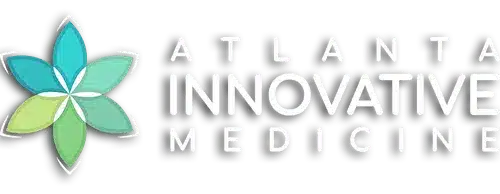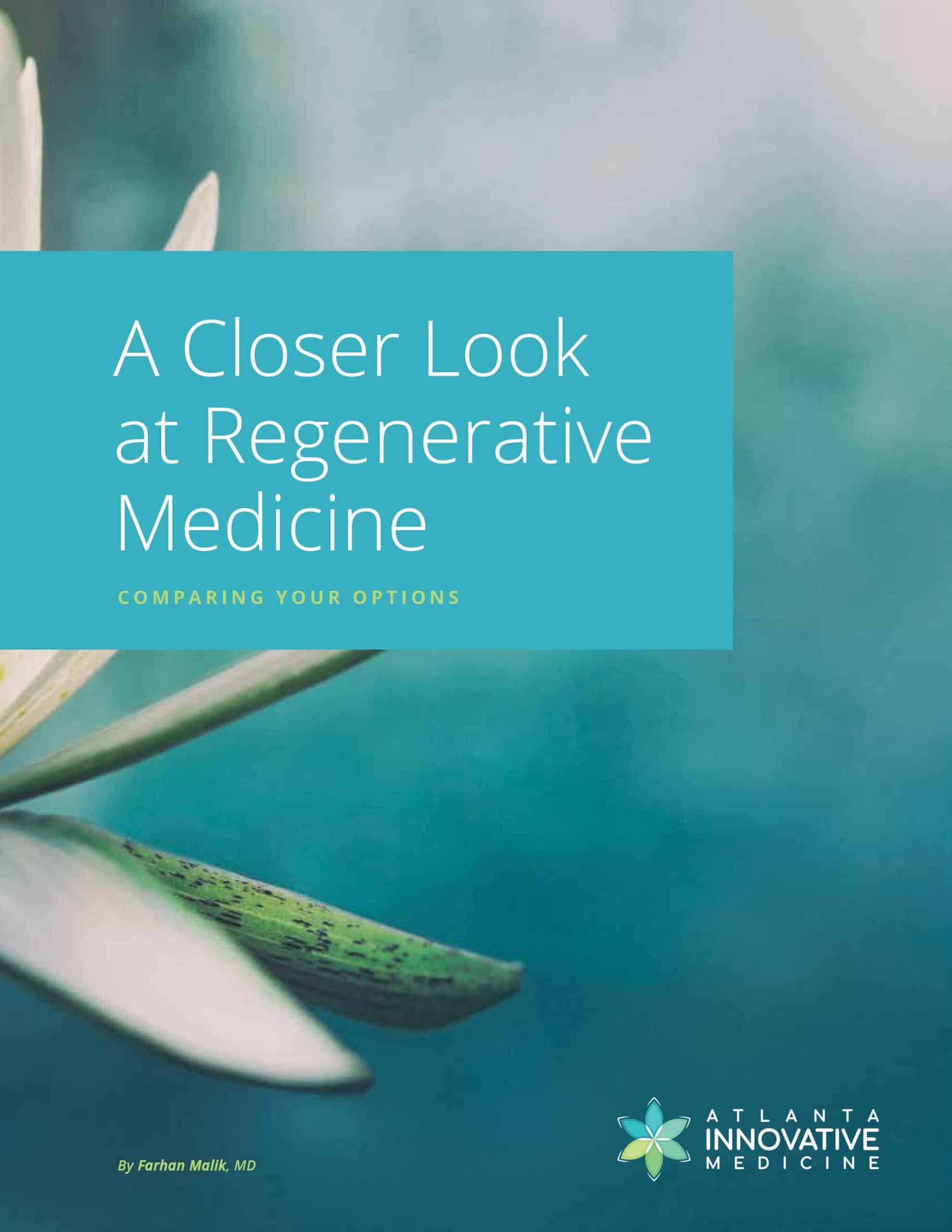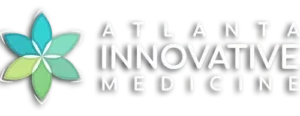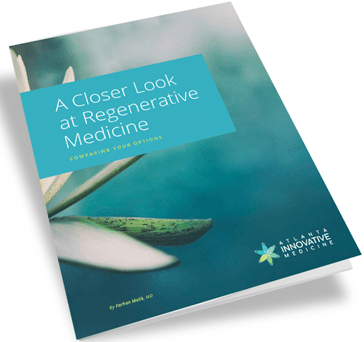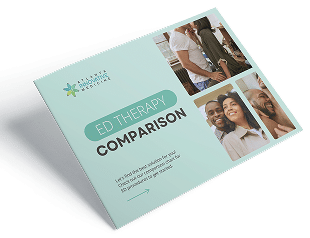By Farhan Malik, MD
Atlanta Innovative Medicine
When researching a regenerative procedure such as stem cell therapy, patients may feel most comfortable choosing a treatment using their own tissue. This is called receiving an “autologous” procedure, which means the tissue comes from the patient himself/herself.
Atlanta Innovative Medicine offers patients options for both autologous adipose and bone marrow stem cell therapy. This article focuses on the question we hear a lot: “I want to use my own tissue, would it be better with adipose or bone marrow?”
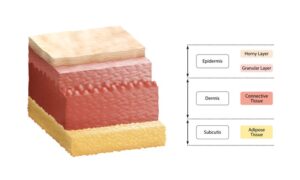
First of all, let’s clarify where the tissue is coming from. Adipose is the medical term for fat tissue, and we obtain it from a patient’s abdominal area. The harvesting procedure involves taking out about 60 cubic centimeters of fat, so patients do get the benefit of a slight liposuction too.
During a bone marrow stem cell procedure, the tissue is obtained from an area known as the iliac crest which is close to the hip area in the pelvis. A large bone marrow aspiration needle is placed into the bone, and about 10–20 cubic centimeters of bone marrow tissue is withdrawn.
While both adipose and bone marrow stem cells are considered safe and effective for regenerative therapy, there are several differences in their regenerative qualities and in their extraction procedures that can determine which will be more effective for a particular patient.
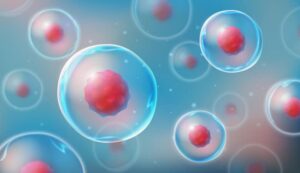
- Amount of stem cells: Both adipose and bone marrow tissues contain millions of stem cells in even very small amounts of tissue. However, adipose tissue tends to contain an even larger volume of stem cells. Because of this, adipose is generally the preferred method for patients treating several different joints or soft tissue areas, as the higher yield of stem cells makes it easier to treat multiple pain points with fewer harvests of tissue. Additionally, because a person’s bone marrow tissue decreases over time, it can become more difficult to harvest enough bone marrow for a sufficient number of stem cells after a certain age. For this reason, adipose is sometimes recommended for older adults as well.
- Number of growth factors: Both bone marrow and adipose tissues wield more than 50 different types of growth factors. However, the cells drawn from bone marrow tend to have even more growth factors. This makes bone marrow a common choice for more extensive injuries which require a higher level of regrowth.
- Invasiveness of procedure: Both harvesting procedures are safe, minimally invasive, and extremely well tolerated. After the area is numbed, a small incision is made either in the abdomen (for adipose) or in the iliac crest (for bone marrow); and from there, tissue is collected with a syringe. The procedure is routinely performed in our office, and while the biopsy itself can involve mild to moderate pain, the use of numbing medicine allows for minimal pain. While some patients report mild to moderate pain or mild bruising for a couple of weeks following bone marrow aspiration, most patients do not report significant pain with either procedure.
- Research & outcomes: Both autologous adipose and bone marrow stem cell therapies have repeatedly shown remarkable outcomes for chronic joint pain (Regen Med 2019). Because bone marrow has been used in stem cell therapy for a longer period of time, there are more studies showing its regenerative capacity.
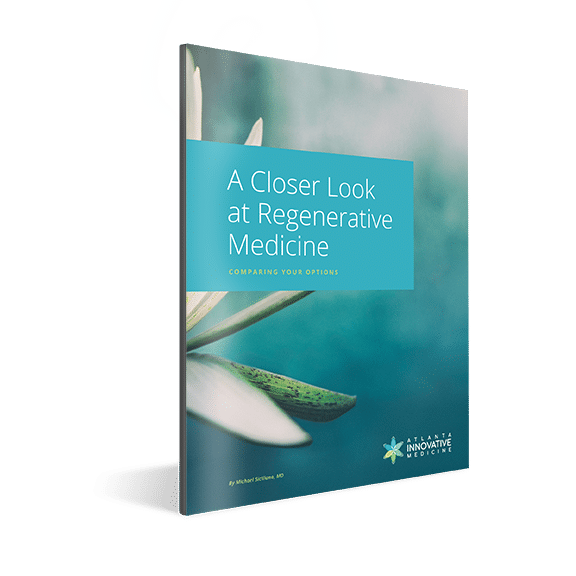
Subscribe for Expert Insights and Our Ebook
A Closer Look at Regenerative Medicine: Comparing Your Options Learn about treatment options like Platelet Rich Plasma (PRP), Prolozone Therapy, and Stem Cell Therapy.

Quizzes
Are you a candidate for Regenerative Medicine?
Regenerative medicine can be an effective therapy and treatment option for lasting pain relief for a variety of conditions like osteoarthritis of the knee, hip or shoulder; ACL or meniscus tears; tennis or golfer’s elbow; chronic neck and back pain; and more.
Is it right for you and your condition? Take 1 minute to answer a few “yes or no” questions that help to assess if you might be a candidate for PRP, stem cell, or other nonsurgical regenerative treatments.
Are You a Stem Cell Candidate for Your Joint or Spine Damage?
Are you a candidate for Platelet Rich Plasma (PRP) Therapy?
Do I have nonsurgical options for my injured or aging joints?
Take the Pain Medications Risk Quiz

Regenerative Medicine.
Reimagined
- Advanced hybrid therapies, including Mesenchymal Stem Cell therapy combined with different mechanisms of action that synergistically come together to support ultimate healing
- More powerful PRP that’s customized, amplified and personalized
- Therapies delivered by an experienced, compassionate team comprised of multidisciplinary experts in traditional and alternative medicine working as your team: Medical Doctors, Nurse Practitioners, Physiotherapists and Chiropractors
- Advanced training through the American Academy of Orthopedic Medicine, the American Osteopathic Association of Prolotherapy Regenerative Medicine, and more
All content of this page is for informational purposes only and is not intended to serve as a substitute for the consultation, diagnosis, and/or medical treatment of a qualified physician or healthcare provider. Individual results may vary. Your medical professional can explain all the risks and potential benefits of any therapy based on your specific circumstances. At this time regenerative therapies are not FDA approved. Neither Atlanta Innovative Medicine nor its physician affiliates promise regenerative therapies as a cure for any condition, disease, or injury.
Other Atlanta Areas We Service:
© 2024 Atlanta Innovative Medicine, LLC. All Rights Reserved. AIM Scholarship Opportunity
